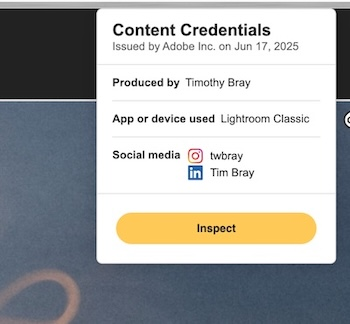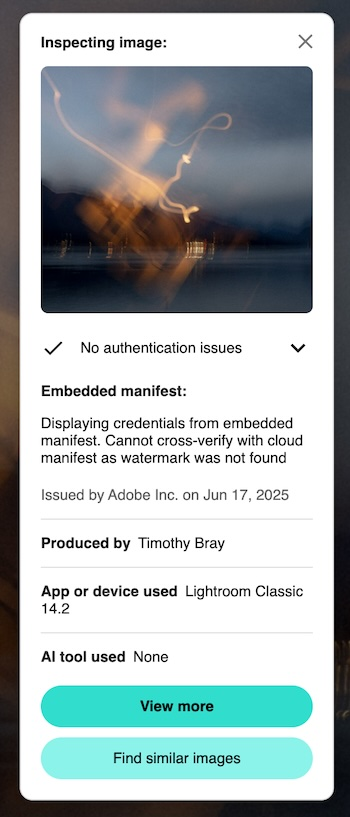Things are happening in the C2PA world; here are a couple of useful steps forward, plus cheers and boos for Adobe. Plus a live working C2PA demo you can try out.
Refresher: The C2PA technology is driven by the Content Authenticity Initiative and usually marketed as “Content Credentials”. I’ve written before about it, an introduction in 2023 and a progress report last October.
Let’s start with a picture.
I was standing with the camera by the ocean at dusk and accidentally left it in the “B” long-exposure setting, so this isn’t really a picture of anything but I thought it was kinda pretty.
Validating Content Credentials · As I write this, there are now two C2PA-validator Chrome extensions: the ContentLens C2PA Validator from ContentLens and C2PA Content Credentials from Digimarc.


If you install either of them, and then you click on that picture just above in Chrome to get the larger version, then you right-click on the larger picture, the menu will offer Content-Credentials validation.
Doing this will produce a little “CR” logo at the top right corner, meaning that the C2PA data has been verified as being present and signed by a trusted certificate issuer, in this case Adobe.
Then there’s a popup; the two extensions’ are on the right. They’re different, in interesting ways. Let’s walk through the second one.
The little thumbnail at the top of the popup is what the image looked like when the C2PA was added. Not provided by the other verifier.
The paragraph beginning “Displaying credentials…” says that the C2PA manifest was embedded in the JPG as opposed to stored out on the cloud; The cloud works fine, and is perhaps a good idea because the C2PA manifest can be quite large. I’m not clear on what the “watermark” is about.
“Issued by Adobe” means that the Chrome extension verified the embedded C2PA against Adobe’s public key and can be confident that yes, this was really signed by them.
“Produced by Timothy Bray” is interesting. How can it know? Well, it turns out that it used LinkedIn’s API to verify that I am timbraysoftwareguy over on LinkedIn. But it goes further; LinkedIn has an integration with Clear, the airport-oriented identity provider. To get a Clear account you have to upload government-issued ID, it’s not trivial.
So this short sentence expands to (take a deep breath) “The validator extension verified that Adobe said that LinkedIn said that Clear said that the government ID of the person who posted this says that he’s named Timothy Bray.”
Note that the first extension’s popup also tells you that Adobe has verified what my LinkedIn and Instagram accounts are. This seems super-useful and I wonder why the other omits it.
“App or device used…” is simple enough, but I’m not actually sure how it works; I guess Adobe has embedded a keypair in my Lightroom installation? If I’d taken the picture with a C2PA-equipped camera this is where that history would be displayed.
“AI tool used None”. Interesting and useful, since Adobe provides plenty of genAI-powered tools. Of course, this relies on Lightroom telling the truth, but still.
The “View More” button doesn’t currently work; it takes you to the interactive contentcredentials.org/verify page, which seems to fail in retrieving the JPG. If you download the picture then upload it into the verify page (go ahead, it’s free) that seems to work fine. In addition to the info on the popup, the verify page will tell you (nontechically i.e. vaguely) what I did to the picture with Lightroom.
What’s good about this? · Well, it’s here and it works! There’s all this hype about how cool it will be when the C2PA includes info about what model of camera and lens it used and what the shutter speed was and so on, but eh, who cares really? What matters to me (and should matter to the world) is provenance: Who posted this thing?
As I write this, supporters of Israel and Iran are having an AI Slop Fight with fake war photos and videos. In a C2PA-rich world, you could check; If some clip doesn’t have Content Credentials you should probably be suspicious, and if it does, it matters whether it was uploaded by someone at IDF.il versus BBC.co.uk.
What’s wrong with this? · Look, I hate to nitpick. I’m overwhelmingly positive on this news, it’s an existence proof that C2PA can be made to work in the wild. My impression is that most of the money and muscle comes from Adobe; good on ’em. But there are things that would make it more useful, and usable by more Web sites. These are not listed in any particular order.
Identity! · Adobe, it’s nice that you let me establish my identity with LinkedIn, Instagram, and Clear. But what I’d really like is if you could also verify and sign my Fediverse and Bluesky handles. And, Fediverse and ATProto developers, would you please, first of all, stop stripping C2PA manifests from uploaded photo EXIF, and secondly, add your own link to the C2PA chain saying something like “Originally posted by @[email protected].”
Because having verifiable media provenance in the world of social media would be a strong tool against disinformation and slop.
Oh, and another note to Adobe: When I export a photo, the embed-manifest also offers me the opportunity, under the heading “Web3”, to allow the image “be used for NFT creative attribution on supported marketplaces” where the supported marketplaces are Phantom and MetaMask. Seriously, folks, in 2025? Please get this scammy cryptoslime out of my face.
Browsers please… · This was done with Chrome extensions. There are people working on extensions for Firefox and Safari, but they’re not here yet. Annoyingly, the extensions also don’t seem to work in mobile Chrome, which is where most people look at most media.
I would love it if this were done directly and automatically by the browser. The major browsers aren’t perfect, but their creators are known to take security seriously, and I’d be much happier trusting one of them, rather than an extension from a company I’d never previously heard of.
… or maybe JavaScript? · The next-best solution would be a nice JS package that just Does The Right Thing. It should work like the way I do fonts: If you look in the source for the page you are now reading, the splodge of JS at the top includes a couple of lines that mention “typekit.com”. Typekit (since acquired by Adobe) offers access to a huge selection of excellent fonts. Those JS invocations result in the text you are now reading being displayed in FF Tisa Web Pro.
Which — this is important — is not free. And to be clear, I am willing to pay to get Content Credentials for the pictures on this blog. It feels exactly like paying a small fee for access to a professionally-managed font library. Operating a Content-Credentials service wouldn’t be free, it’d require running a server and wrangling certs. At scale, though, it should be pretty cheap.
So here’s an offer: If someone launches a service that allows me to straightforwardly include the fact that this picture was sourced from tbray.org in my Content Credentials, my wallet is (modestly) open.
By the way, the core JavaScript code is already under construction; here’s Microsoft and the Content Authority Initiative itself. There’s also a Rust crate for server-side use, and a “c2patool” command-line program based on it..
Open-Source issues · You’ll notice that the right-click-for-Content-Credentials doesn’t work on the smaller version of the picture embedded in the text you are now reading; just the larger one. This is because the decades-old Perl-based ongoing publishing software runs the main-page pictures through ImageMagick, which doesn’t do C2PA. I should find a way to route around this.
In fact, it wouldn’t be rocket science for ImageMagick (or open-source packages generally) to write C2PA manifests and insert them in the media files they create. But how should they sign them? As noted, that requires a server that provides cert-based signatures, something that nobody would expect from even well-maintained open-source packages.
I dunno, maybe someone should provide a managed-ImageMagick service that (for a small fee) offers signed-C2PA-manifest embedding?
What’s next? · The work that needs to be done is nontrivial but, frankly, not that taxing. And the rewards would be high. Because it feels like a no-brainer that knowing who posted something is a big deal. Also the inverse: Knowing that you don’t know who posted it.
Where is it an especially big deal? On social media, obviously. It’s really time for those guys to start climbing on board.
.png)



